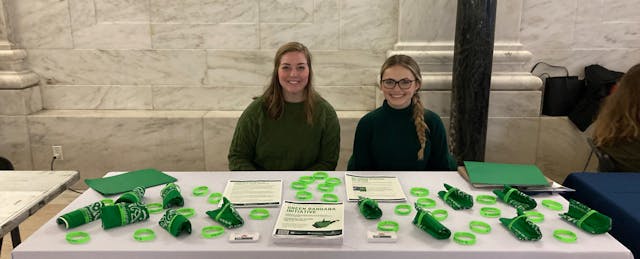Alyssa Parks first made an appointment at the counseling center at Marshall University thanks to her roommate. The young woman had mentioned to Parks how comfortable she felt receiving care at the facility and how nice the staff were.
So when Parks learned during a conference for student-government leaders about a program that teaches young adults to offer mental health support to their peers, she thought it would work well at Marshall—and even beyond, at colleges throughout West Virginia.
The Bandana Project started at the University of Wisconsin-Madison. The program teaches students how to help friends who are in distress until they have the opportunity to seek professional guidance. The initiative also aims to alleviate the shame that can surround mental health care by encouraging students to don a bright symbol of support in public.
“Once you take the training, you get a green bandana, and you put it on a book bag or purse to show that you’re comfortable with someone asking you for help if they’re going through a mental health crisis,” Parks explains. “There is a stigma about that topic, and I think it’s getting better, but sometimes it’s nerve-wracking if you’ve never been to the counseling center.”

Photo courtesy of WVHEPC.
Parks was in a strong position to help green bandanas proliferate among her classmates. In 2021 and 2022, she was Marshall’s student body president, and she also served as the chair of West Virginia’s student advisory council.
During one council meeting, Parks pitched the idea of offering mental health peer-support training across the state. Other student representatives agreed, noting how long students had to wait for counseling appointments at their colleges. Collaborating with state officials, the student council created the Green Bandana Initiative and rolled it out at higher ed institutions throughout West Virginia.
“If you’re having a mental health crisis, four weeks is too long and too late” to wait to see a therapist, Parks says. “Green Bandana was a way to supplement that long wait and help students have someone to talk to in between that time.”
This kind of peer-support effort is one way that college students and their institutions are responding to the mental health crisis that experts say is happening among adolescents—and therefore playing out on higher ed campuses—across the U.S.
These programs have the potential to help students with “subclinical issues,” says a report by the Mary Christie Institute published in 2022. After all, the report notes, when students experience distress, they usually talk about it first with each other.
But such programs also carry risks, according to the study, which calls for further research to be conducted to assess how well peer-support efforts actually work and to determine best practices for running them.
Students Fill the Gap
Research shows that rates of depression and anxiety reported among young people have soared, leaving colleges struggling to figure out how to respond. In 2019, more than 87 percent of counseling center directors reported that more students were seeking services, according to the Association for University and College Counseling Center Directors annual survey.
The COVID-19 health crisis exacerbated the strain on both young people and the campus systems that support them. Nearly three-quarters of college students said they had experienced moderate to serious psychological distress during the pandemic, according to the National College Health Assessment, a study of more than 33,000 students at 41 higher ed institutions conducted by the American College Health Association in fall 2021.
“Having a job, trying to keep up with your classes—and in the middle of the pandemic, especially when quarantined—did have a big effect on everyone’s morale,” Parks says. “People had to take off work, and that creates stressors. You can’t afford groceries or housing, you’re also worried about a test you have coming up. Maybe you’re really stressed and like to socialize to destress, and you can’t do that during the pandemic. The combination of all those things—that really puts a damper on mental health.”
How responsible should colleges be for providing access to mental health care? Higher ed leaders are still trying to figure that out. But Parks sees a direct connection between how well young people feel and their academic performance.
“Something I noticed talking to a lot of different students, you really have such a hard time being successful at your schooling and being the best you can be when your mental health doesn’t come first,” Parks says. “I notice a difference: When students are able to take care of their mental health first, they’re able to succeed at other aspects of their life.”
So while colleges and their health teams adapt to the increased need for mental health services on campus, students are stepping up to support their peers, by running phone hotlines and texting services, offering coaching and hosting campus events. A 2021 survey from the Born This Way Foundation and the Mary Christie Institute found that 20 percent of 2,000 student respondents had used peer counseling, while 62 percent of those who hadn’t expressed interest in trying it.
Peer-support programs vary widely depending on the type of interventions they offer. Some enlist students to provide preventive education, others involve students lending a listening ear to their classmates and still others see students acting as coaches—or even counselors.
The level of training these programs require of student participants varies, too. For example, the training offered at Marshall University through the Green Bandana Initiative takes a few hours to complete, Parks says, while training at a more-intensive peer-counseling program offered at the University of Albany takes place during a semester-long course.
Inconsistencies in training are one of the causes of concern named in the 2022 Mary Christie Institute report.
“The clinicians and students we spoke to point to ample training for peer supporters as the most important element of risk mitigation, with knowing the limits of the service and understanding protocols for urgent situations being of highest priority,” the report authors wrote. “This is clearly an area that can be strengthened, starting with standardizing a level of training generally and by program type.”
And it’s not always clear how well peer-support programs work. An article published in 2022 in the journal PLOS ONE reviewed multiple studies about interventions intended to improve mental health among college students, and it found that peer support provided effective treatment for depression and anxiety. By contrast, a different academic article reviewing multiple studies determined there is not enough evidence to suggest that peer support improves mental well-being among college students.
Still, the Mary Christie Institute report asserts that with the right practices, resources and evaluations, “Peer support programs can inoculate against worsening health problems that, like in physical health, become acute if left unaddressed.” These programs seem especially promising for helping students from racial minority groups feel “understood and validated, while increasing their sense of belonging on campus,” it adds.
Bearing the Bandana
After student leaders in West Virginia decided to adopt the Green Bandana program, they worked with the director of behavioral health programs for the West Virginia Higher Education Policy Commission to set up training opportunities for students at universities throughout the state. The commission covered the training fee, making it free to participate.
Student volunteers at each institution spread the word to their classmates through social media and by passing out information at tables set up on campuses. At Marshall University, Parks says, Greek life organizations joined in the effort, encouraging their members to sign up.

Between late February and mid-June of 2022, about three dozen training sessions were held at colleges across the state, with enough capacity for hundreds of students to participate. When Parks took the training, she says she learned how to recognize signs of mental health crises, including anxiety and risk of suicide, and how to approach a friend with sensitivity.
One particular training video resonated especially with her. It depicts two friends out at a restaurant. The first friend is overwhelmed by a panic attack and disappears, prompting the second friend to text, “Are you OK?” The two friends reunite, and together take deep breaths and complete a counting exercise. Then the second friend asks, “Have you gone to counseling? I would be more than happy to take you there.”
This exchange reminded Parks of how her roommate set an example for Parks to follow regarding her own mental health.
“That first counseling session can be uncomfortable if you’ve never been to one before,” Parks says. “I related to the aspect of having a friend notice and be able to go through that experience with you.”
Parks keeps her green bandana tied around the bottom of her backpack. And although it hasn’t yet attracted anyone seeking support, she feels the training she completed has prepared her for that possibility.
“I think it helped me feel more confident in how to address the situation if my friend ever did need someone to talk to,” she says.


